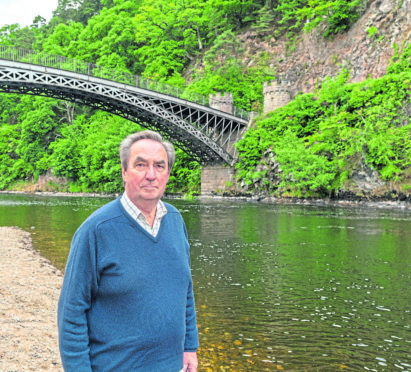Emergency talks have been scheduled in an attempt to reverse a dramatic decline in the amount of salmon caught on the River Spey.
Dry weather has caused water levels to drop, adding to concerns about the amount of fish returning to the river from previous years.
The heatwave that has swept the country has now caused the river to drop to levels that were last seen during the drought in 1976.
Angling clubs have reported that catches so far this year are five times less than those caught during the same period in 2017 – which was described as a “challenging” season by the Spey Fishery Board.
Now the group has organised a special meeting next week in an effort to continue “aggressive” work to draw up potential solutions.
Meanwhile, the Scottish Government has pledged to help the organisation in efforts to safeguard the species, which generates more than £10million every year for communities that line its banks.
Brian Doran, chairman of the Spey Fishery Board, said: “There have been particularly poor spring catches with widespread concern about the decline in the numbers of adult salmon returning to the river.
“We recognise these concerns remain and have been exacerbated by particularly low water levels and a prolonged spell of dry, very warm, weather.
“We have every sympathy for the proprietors, ghillies and visiting anglers in these exceptional and particularly difficult times. We are working actively and aggressively to consider all options.”
Salmon are attracted to migrate up the River Spey when large amounts of water flow down it into the Moray Firth. Warm temperatures in the river also make staying in the cooler sea water more appealing for the fish.
During 2017, a total of 5,292 fish were caught along the length the Spey following an encouraging start but slow end to the season. That figure was 2,341 lower than 2016 but still above the all-time low of 4,463 recorded in 2014.
Reports are currently being compiled from beats to collate totals from the beginning of the season in February until the end of June.
However, early indications from the Fochabers Angling Association show a dramatic decline.
President Gordon Young said: “On our beat we’ve only caught about 20 salmon since the season started on February 11. About 100 would have been caught during the same period last year.
“It’s the poorest start to the season in living memory. There’s so few fish returning to the river. The reason for that is that the water is so low, it’s the lowest I have ever seen it.
“All we can do is hope for rain at the moment. Once there is a spate then they should return in large numbers.”
Mr Young acknowledged that the River Spey is a popular draw for anglers from across the world who would be disappointed if the problems continue.
He said: ”We still have guests down every day, including from America and Europe. Obviously they’ve already made arrangements for this year but their hopes must be severely dashed when they see the state of the river.”
The Scottish Government has recently announced a £500,000 project to examine reasons for pressures on salmon stocks – including forestry, barriers that prevent migration, illegal poaching and fish farming.
A spokesman said: “The decline in wild salmon numbers is due to a range of complex factors and is of great concern. We are working with key partners, including the Spey Fishery Board, to safeguard the future of this iconic species.”
